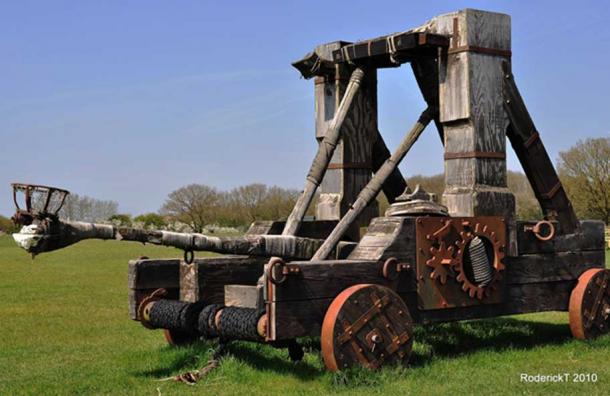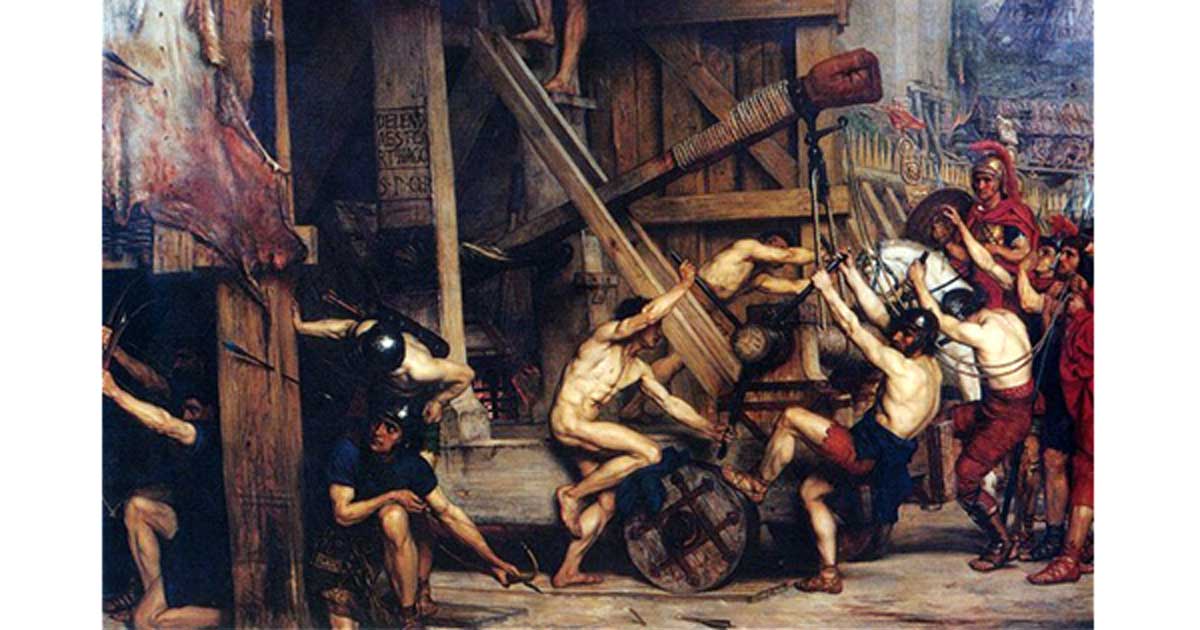Were Catapults the Secret to Roman Military Success?
The Roman Empire conquered the known world in large part due to its army. The Roman Army was a formidable force of training and discipline led by military minds who established organizational and tactical strategies that have influenced the world up to this very day. In short, the Roman army was one of the most effective and enduring forces in military history. In addition to skill and zeal, the Romans also had a more material advantage on their side: siege weapons, such as catapults.
Catapults and Other Ancient War Technology
Thanks in large part to Greek innovations, the Romans represented the acumen of applied technology in the ancient world. Siege weapons, such as catapults, scorpions, and battering rams, gave the Romans an unprecedented advantage offensively as well as defensively. The Romans used these advanced weapons to deadly effect.
“He was amply supplied with ‘quick-firers,’ catapults and ‘stone-throwers,’ with which he not only beat off his assailants but also killed many of the worshippers… For the missiles from the engines flew over with such force that they reached the altar and the sanctuary, lighting upon priests and sacrificers; and many who had sped from the ends of the earth to gather round this far-famed spot, reverenced by all mankind, fell there themselves before their sacrifices, and sprinkled with libations of their own blood that altar universally venerated by Greeks and barbarians. The dead bodies of natives and aliens, of priests and laity, were mingled in a mass, and the blood of all manner of corpses formed pools in the courts of God. What misery to equal that, most wretched city, hast thou suffered at the hands of the Romans.”
(Josephus The Jewish War Book V, written circa 75 AD.)
- The Devastating and Diabolical Ancient Origins of Biological Warfare
- Examining the Impressive Ancient Roman Walls of Lugo
- Catapult: The Long-Reaching History of a Prominent Medieval Siege Engine

Romans arming a catapult. (Public Domain)
The Creation of the Catapult
‘Catapult’ is used to describe all non-gunpowder projectile artillery weapons, especially those in the ancient and medieval world. However, there are many variations and specifications, for instance, in Greek, there were the “ katapeltēs oxybelēs which fired bolts and the lithobolos which fired stones” (Cartwright, 2014). The Romans called their catapults ballistae, from which English gets the word ‘ballistics.’
Catapults were invented in the 4th century BC by Greek engineers. These weapons were basically large bows made of wood, horn, and animal sinew. When a soldier discharged the trigger, heavy projectiles would be launched forth as far as 328 feet (100 meters). This could beat any ancient armor the opponent was wearing, however, it was not strong enough to breach fortifications.
Thus, many sought to increase the catapult’s power. It was Macedonian engineers working under Phillip II (father of Alexander the Great) who are largely credited with adopting torsion power to the catapult. The innovators were “aware that it was the sinew in the bow’s composition that gave it its power, so by using the sinew to form tightly twisted “springs,” the power of the artillery could be increased” (Williamson, 2016). The tightly twisted springs provide torsion power. Alexander used torsion catapults to great effect.
Roman Catapult Advances
Upon coming to power, Romans took up the Greek artillery weapons and improved them in important ways. First, they made the catapults smaller so they could more easily be transported and assembled (these littler catapults were called cheiroballistra). It was a weapon designed to be used against an opposing army or perhaps an opposing naval vessel, but not against a city’s fortifications.
Catapults only became an effective destroyer of walls thanks to the second Roman improvement: the onager. The onager looks very much like the modern concept of a catapult. It has a single arm that hurls a missile, usually a large stone. The missile can weigh up to 350 pounds (160 kilograms).
- Ancient Journeys: What was Travel Like for the Romans?
- Built to Last: The Secret that Enabled Roman Roads to Withstand the Passage of Time
- An Ancient Greek Machine Gun? The Innovative Catapult of Dionysius

Roman onager, catapult with sling. (Public Domain)
The weapon was described by the Roman soldier and historian Ammianus Marcellinus:
“The onager's framework is made out of two beams from oak, which curve into humps. In the middle they have quite large holes in them, in which strong sinew ropes are stretched and twisted. A long arm is then inserted between the bundle of rope, at its end it has a pin and a pouch. It strikes on a huge buffer with a sack stuffed with fine chaff and secured by tight binding. When it comes to combat, a round stone (often clay balls with combustible substance in them, which explode on impact and burst into flames) is put in the pouch and the arm is winched down. Then, the master artilleryman strikes the pin with a hammer, and with a big blow, the stone is launched towards its target.” (Ramsey, 2016)
The onager required a crew of eight soldiers to operate and was not very accurate. Although it was highly effective at destroying fortifications, the onager was not as widely used as the smaller, more portable catapults. The development and use of weapons like the catapult allowed the Roman Empire to conquer the known world.

Replica Roman catapult, Stratford-upon-Avon Armoury, UK (CC BY-NC SA 2.0)
Top Image: Catapulta by Edward Poynter Source: Public Domain
By: Kerry Sullivan
References
Josephus. "The Jewish War." Digital Loeb Classical Library (75): n. pag. Web.
Ramsey, Syed. Tools Of War: History Of Weapons In Ancient Times. N.P.: Alpha Editions, 2016. Print.
Williamson, Mitch. "Torsion Catapults." Weapons and Warfare: History and Hardware of Warfare. N.p., 10 June 2016. Web. https://weaponsandwarfare.com/2016/06/10/torsion-catapults/


















Comments
Romans didn't have trebuchets....more recent invention.
The "replica" Roman catapult appears to have used plywood in the construction of the uprights!!
Not very authentic.
I don't think this article gives enough consideration of the trebuchet.